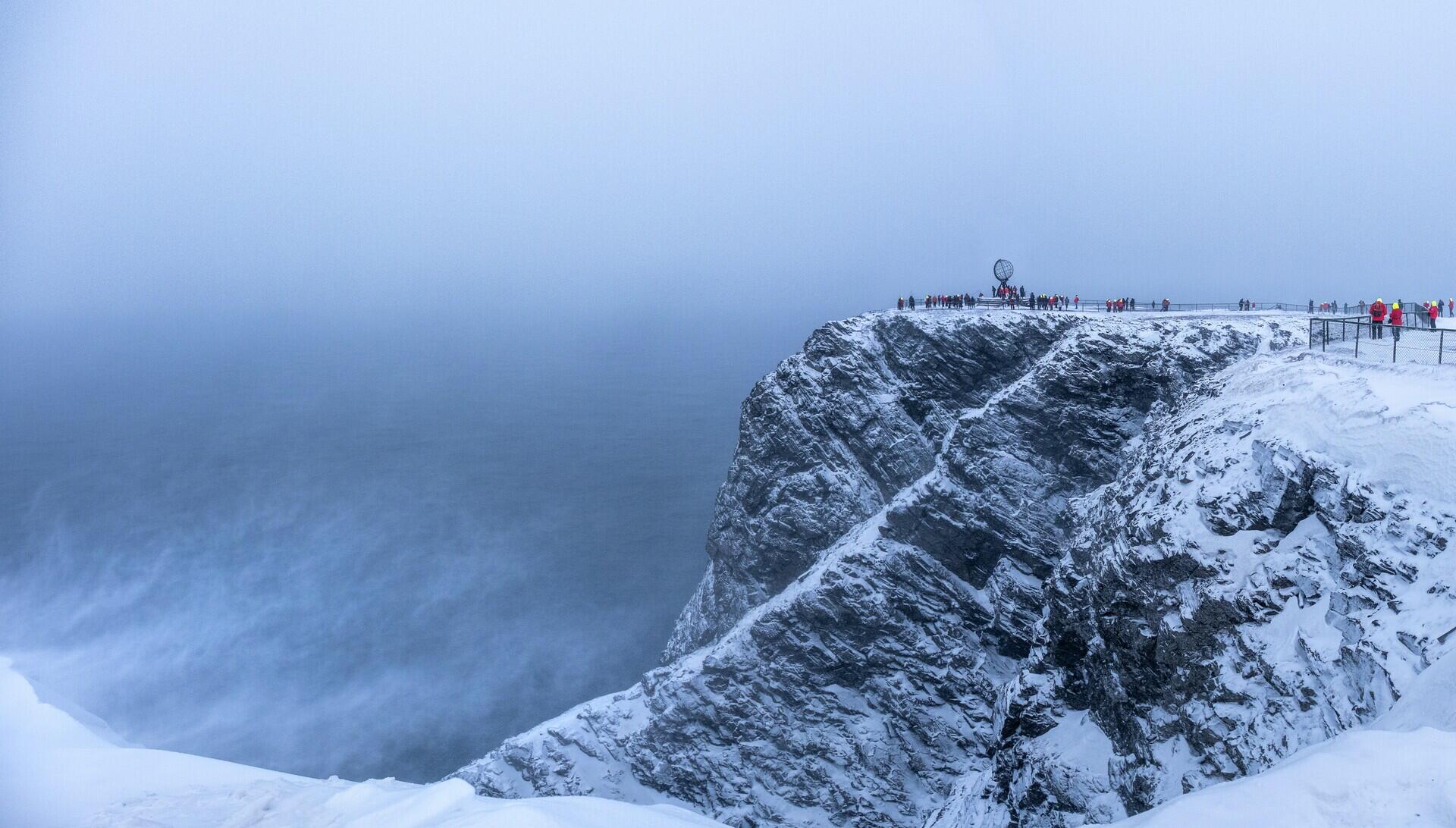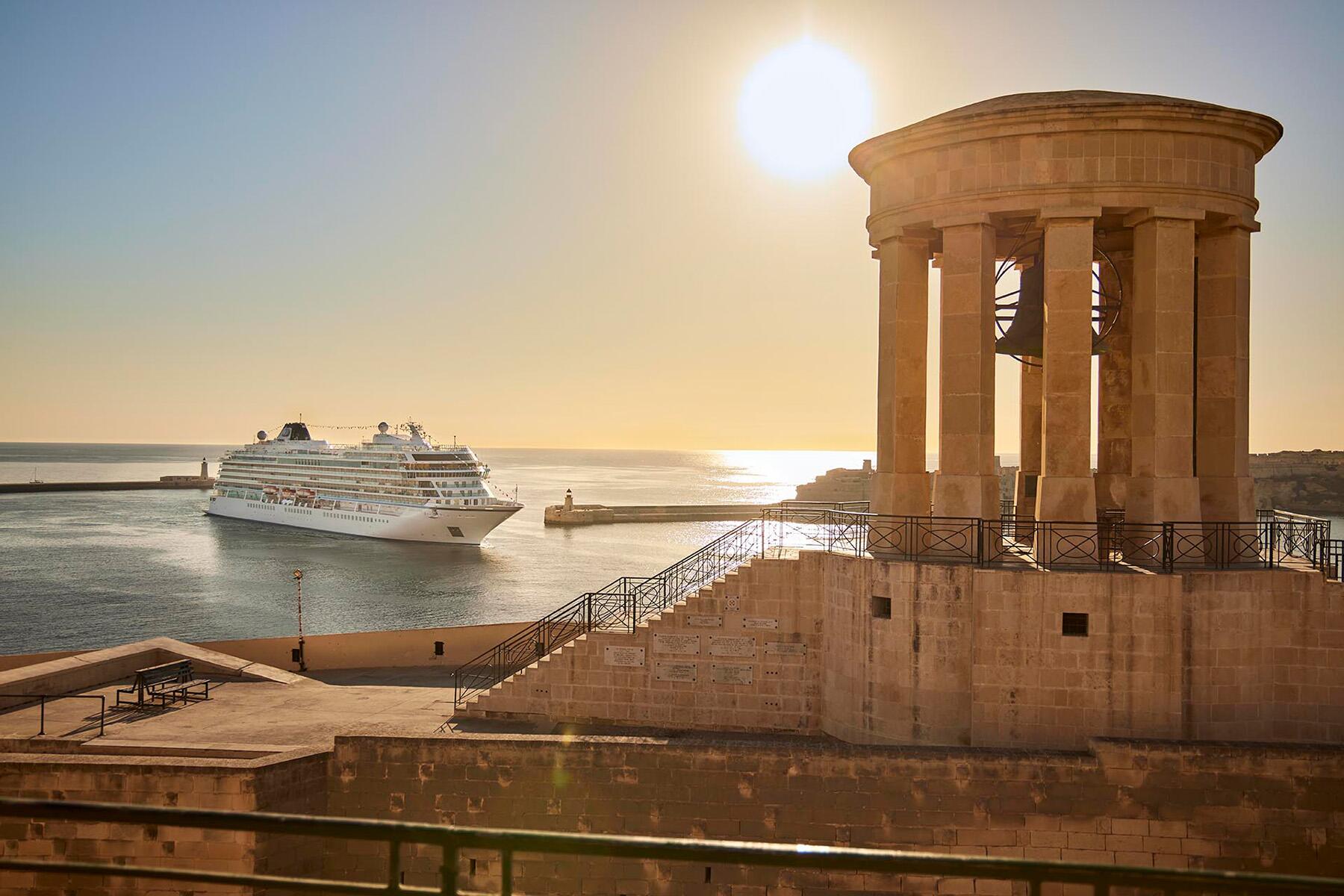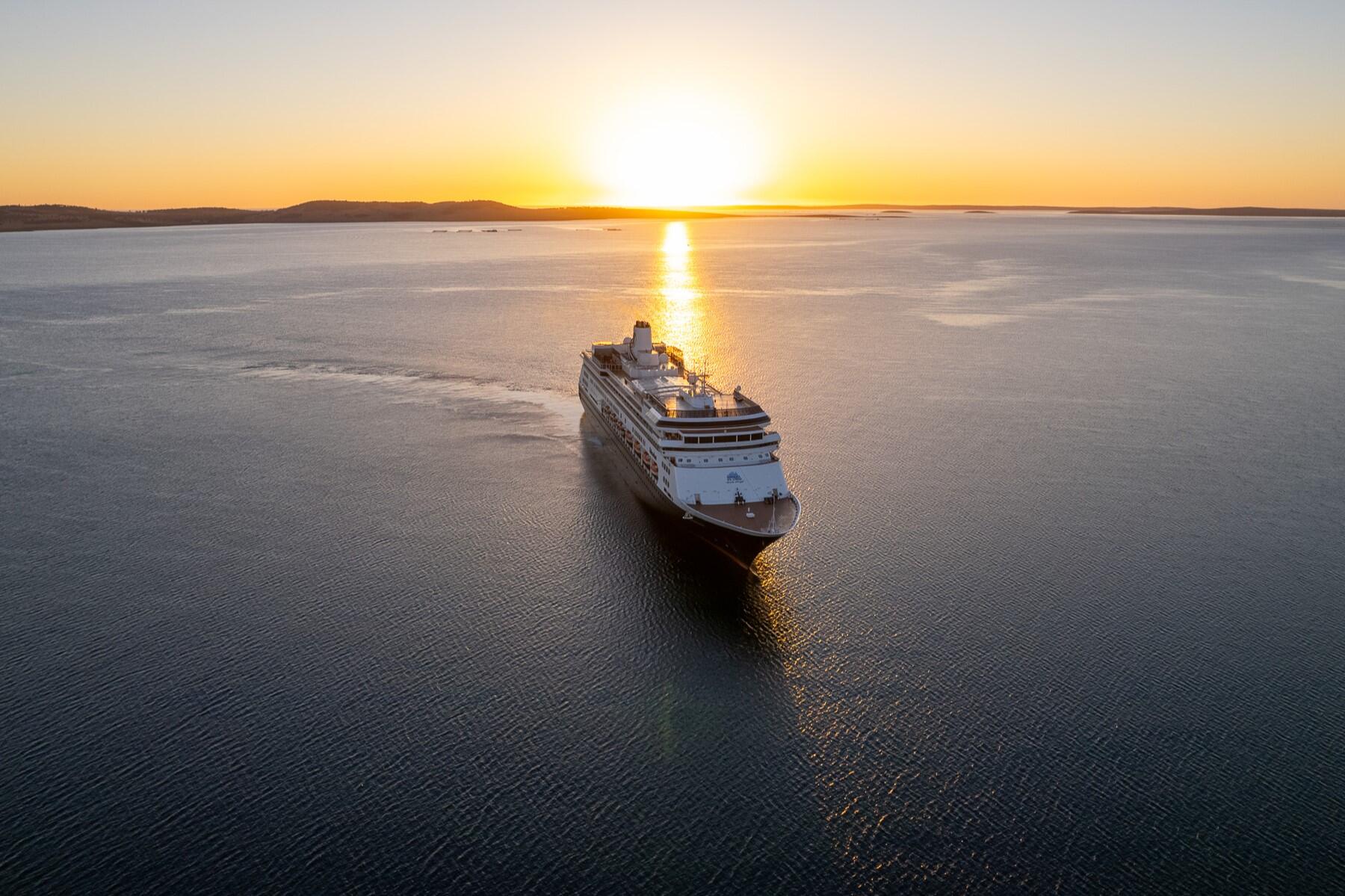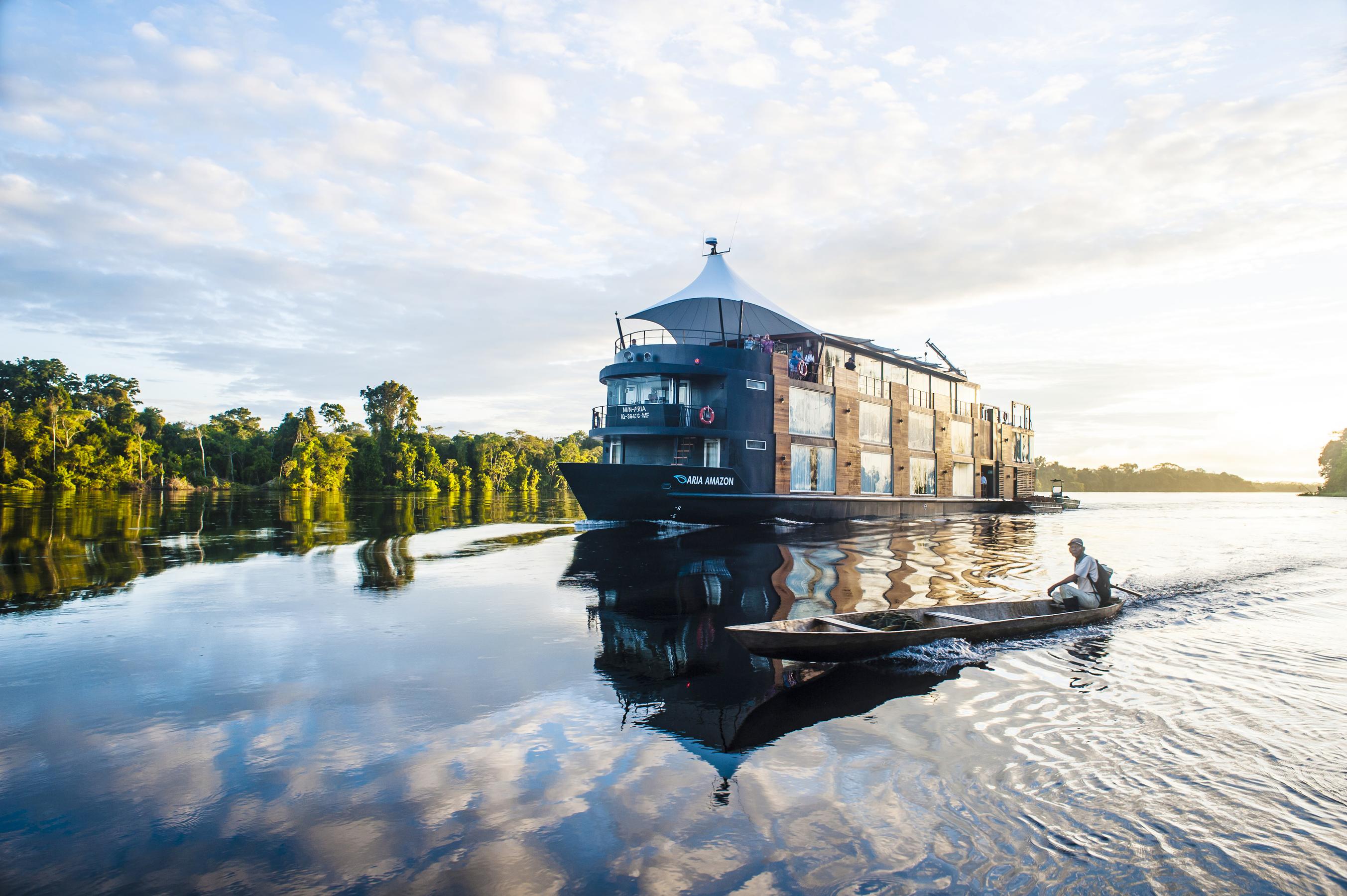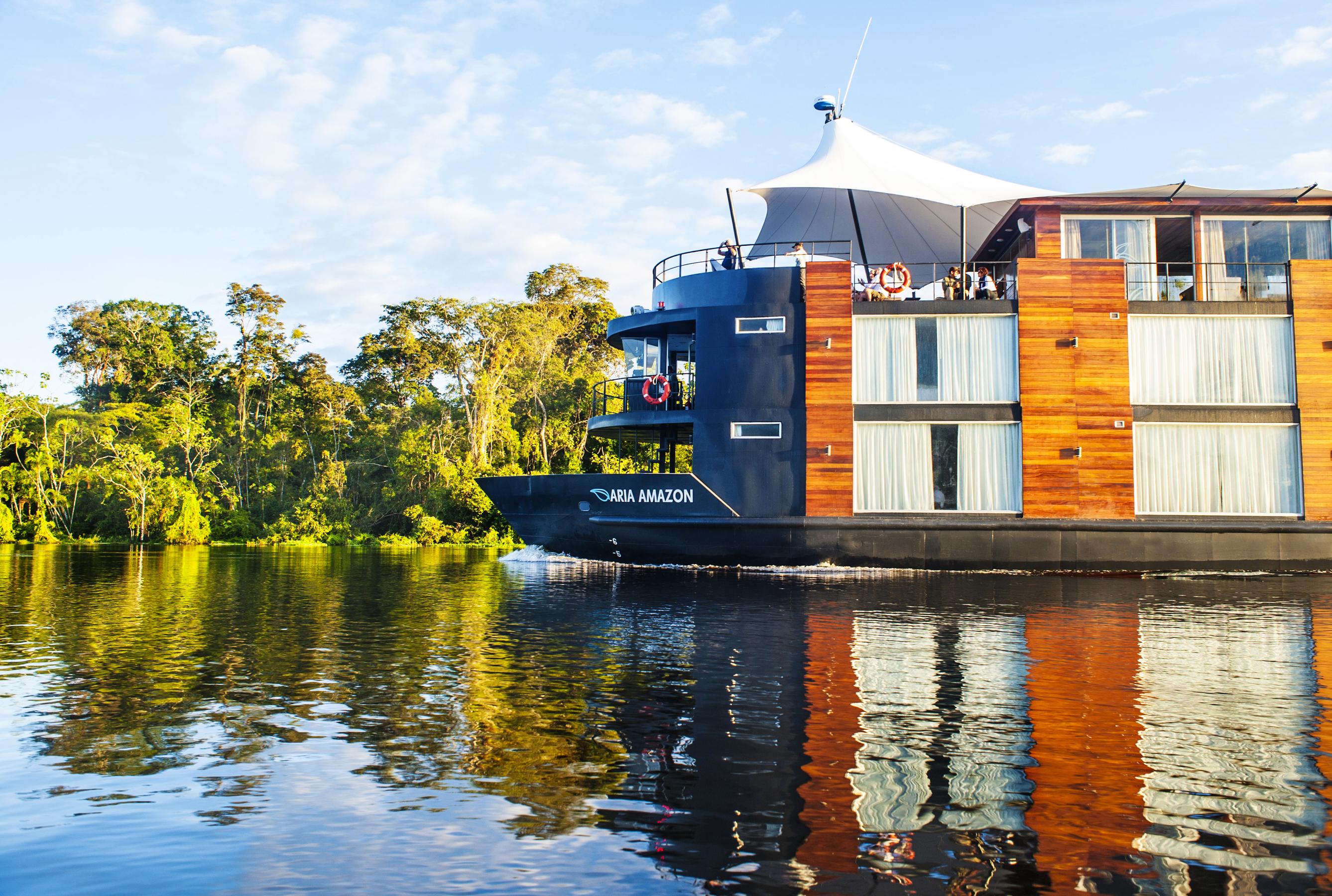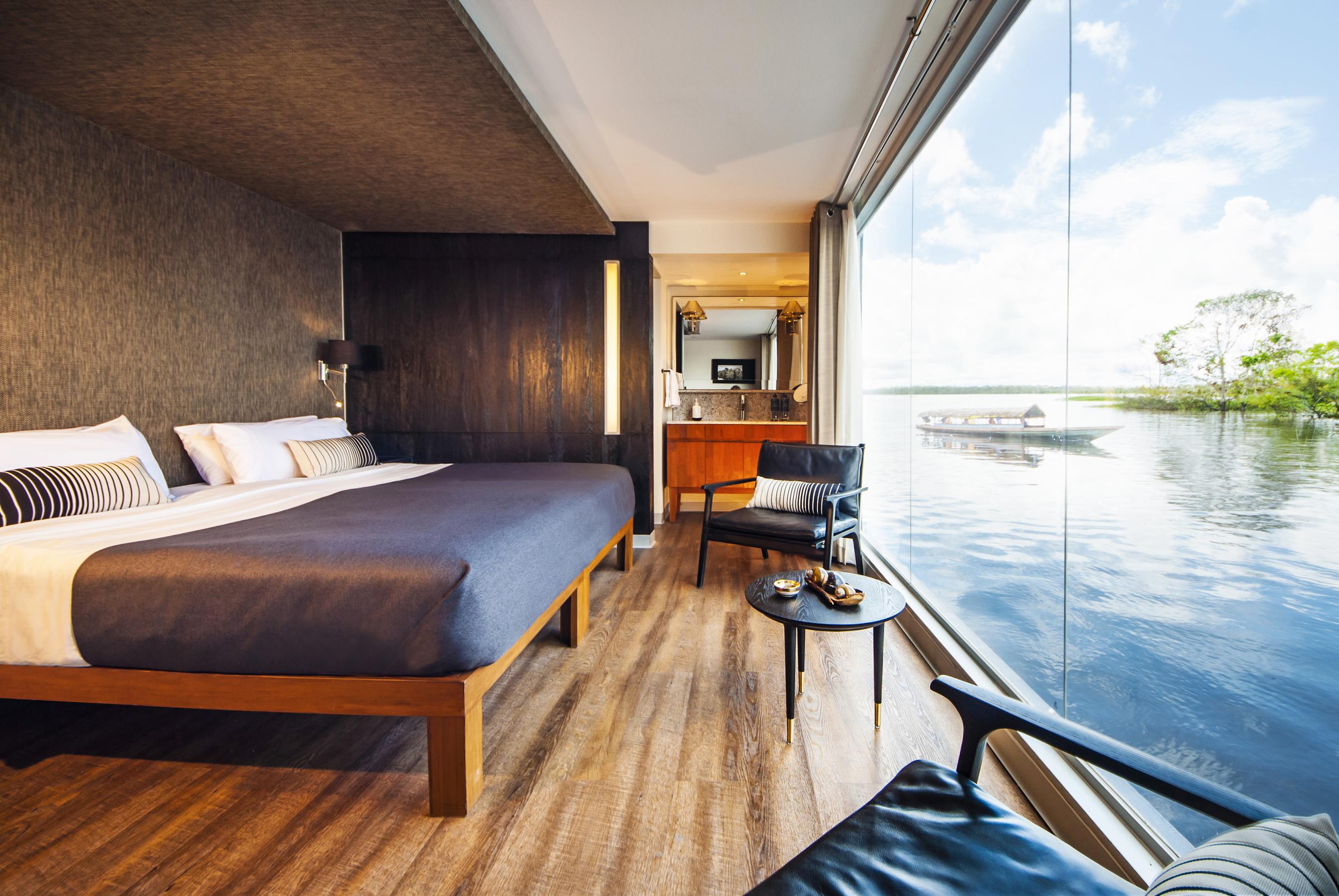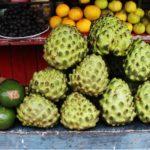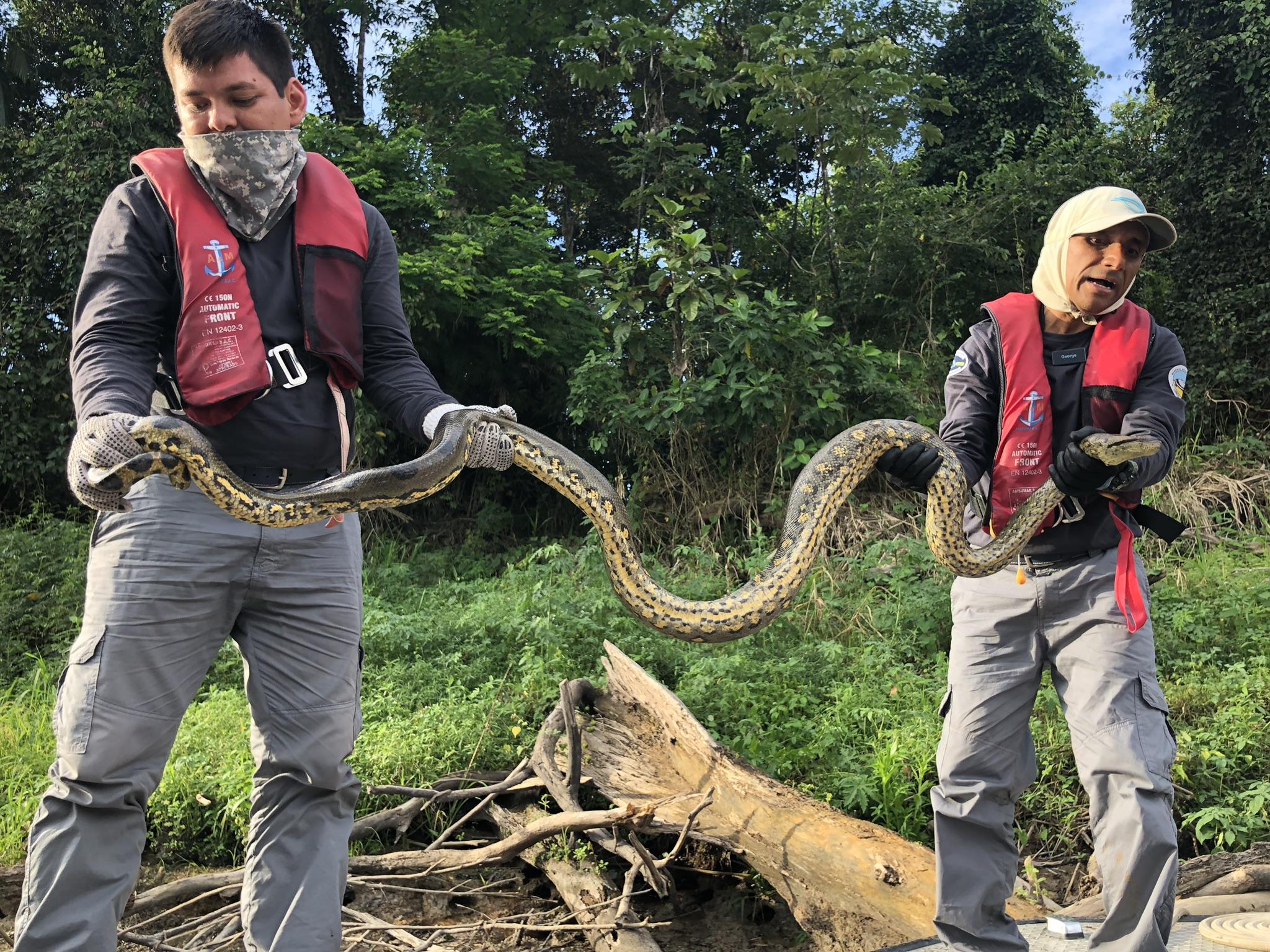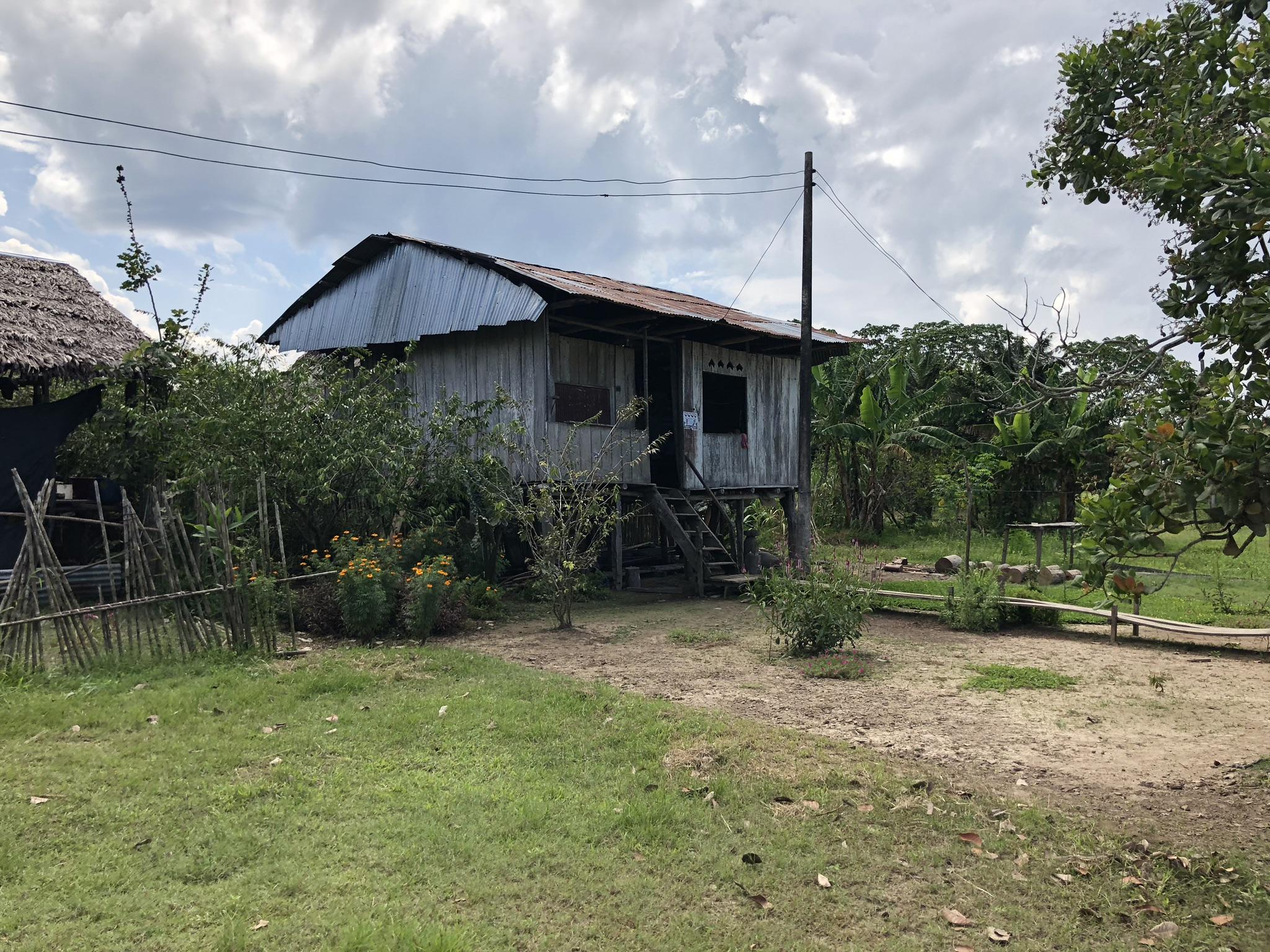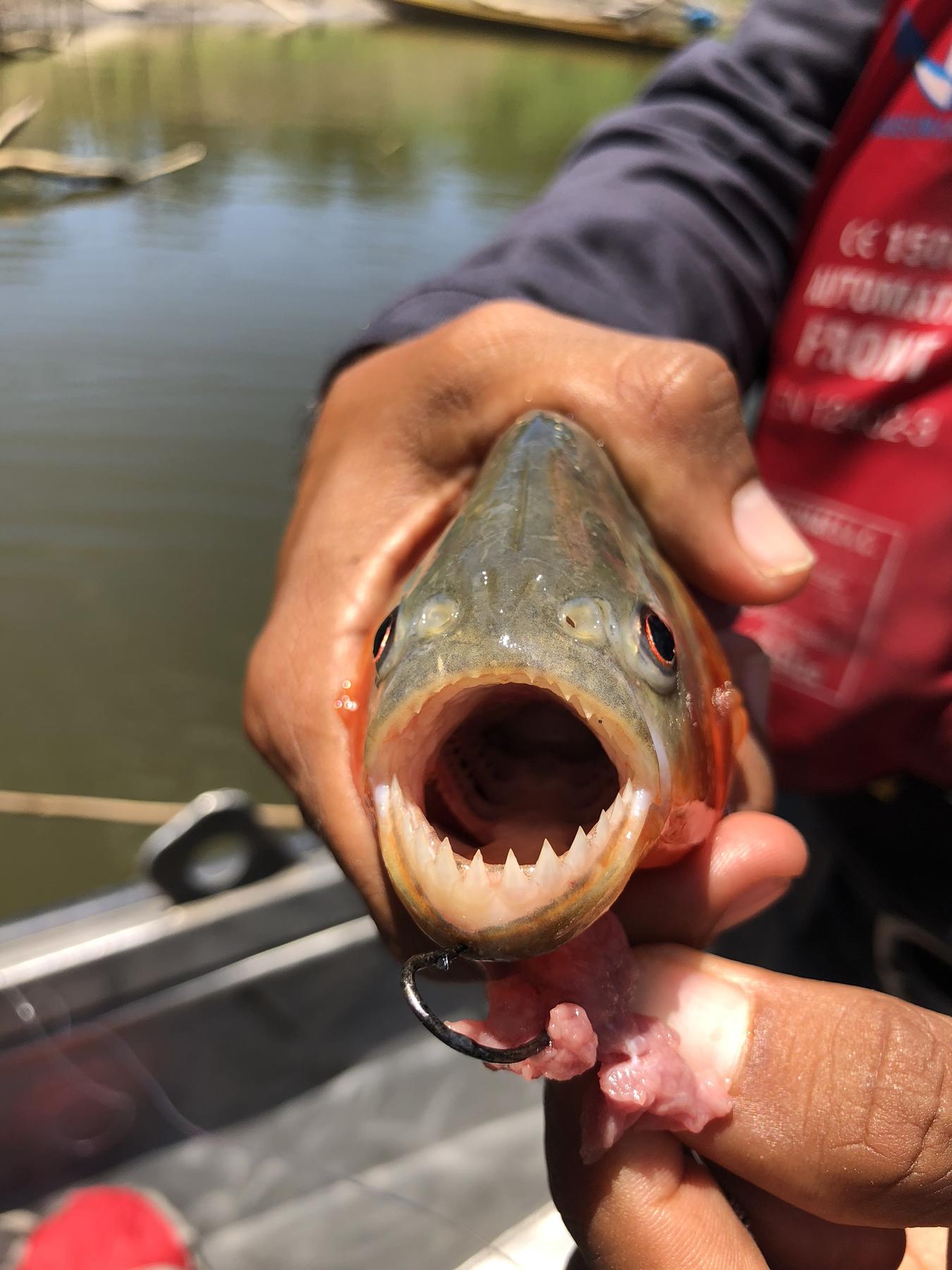A luxury river cruise on the Amazon River is exactly what it sounds like: a once-in-a-lifetime experience.
River cruise travel is having a moment and it’s no surprise. It’s in the sweet spot of cruising: appealing to travelers who have already done the ocean-cruise thing but are looking for something a little different, while also appealing to sworn no-way-never cruisers who are slowly coming around to the fact that these smaller ships offer all the convenience and relaxation of cruising as a mode of travel, minus the crowds and cookie-cutter design of large cruise ships. Now, add an award-winning chef, the feeling of being in a luxurious boutique hotel instead of a floating convention center, a focus on intimate and meaningful cultural experiences, and an itinerary that takes you into one of the world’s best places to spot wildlife, and–why are you not on this cruise already?
Few places have retained their mystery like the Peruvian Amazon. This might have something to do with the fact that there is no cell service or Wi-Fi once you enter it, so instead of firing off your moments in gif-filled Instagram stories, they have time to expand like the evening jungle air to accommodate an incredible volume of sound and feeling.
Recommended Fodor’s Video
I was a placard-carrying member of the never-cruise club until I sailed into Peru’s Amazon rainforest on the sleek and sexy 32-passenger Aria Amazon. The ship, the stylish rooms, the exquisite food, and the incredible crew were the epitome of luxury—but the surprising luxury was the slowing of time, so that four nights in the Amazon feels like the best 10-day vacation you’ve ever had.
Amazon Prime
I met the romantic hero of my Amazon journey on day one, shortly after I arrived in Iquitos, the “Gateway to the Amazon.” As our group of 20 soaked in Peru’s warm morning sun at the Manatee Rescue Center, a short drive from Iquitos airport, we were introduced to some of the area’s wildlife and learned about vulnerable species and local conservation and education efforts. The center is an orphanage for rescued manatee babies whose mothers have been hunted and killed, but you will also find rehabilitating capuchins, macaws, turtles, and sea otters. I met a recovering three-toed sloth, and while he gently snored through our profound moment of connection, I knew this dopey ball of fur was why I was here…and silently vowed to spend the rest of my week, swinging from vine to vine if need be, until I found him in the wild.
After an elegant champagne lunch at the river’s edge in the small town of Nauta, our luggage boarded the sleek, modern boat cozied up to the riverbank while we split into four to six person skiffs to visit the birthplace of the Amazon River. We scooted along the river for the afternoon, the wind filling our metaphorical sails, ears cocked and eyes peeled (mine for sloth sightings), as we leaned forward with every signal from our naturalist guides. Those first few hours were filled with excited dolphin and Harpy Eagle sightings, a walk on the riverbank, giant lily pads that bloom at night, and chilled Peruvian beers to hasten our bond as a group. Idling at the confluence of the Ucayali and Marañón Rivers with a Cusquena beer in hand, suddenly every cheesy travel saying I’ve ever heard rang absolutely true. It really is better to see something once than to hear about it a thousand times. Yes, surely, of all the wonders of the world, the horizon is the greatest. And…ok, you get the idea. It got deep out there.
Floor-to-ceiling windows ensure ever-changing views of occasional remote villages, wildlife, and small fishing boats. Entering my room to that view at sunset, I knew I could never close the blackout curtains.
We came upon the Aria Amazon at sunset. Seeing this elegant boat gliding toward us, its bow nosed high against a backdrop of pink and orange sky, I knew we were in good hands. That first reveal felt completely effortless and yet so very carefully orchestrated, and it absolutely set the tone for service aboard: practiced, thoughtful, and over-delivering on expectations. Following a routine safety drill and introduction to our naturalist guides, we got to explore the ship. The upper deck is the main gathering space, with an indoor lounge featuring comfortable couches, a bar, and floor-to-ceiling windows as well as an outer deck with a hot tub and canopied seating areas–my preferred spot for my sunrise cup of tea. The 16 air-conditioned guestrooms are modern and somehow spacious with strong showers (the ultimate luxury after a hard day adventuring) and again, those floor-to-ceiling windows that ensure ever-changing views of occasional remote villages, wildlife, and small fishing boats. Entering my room to that view at sunset, I knew I could never close the blackout curtains. My apologies, Amazon, I should have packed my fancy pajamas.
The magnificence of the Amazon is the obvious main attraction on this cruise, but the innovative Amazonian cuisine created by Executive Chef Pedro Miguel Schiaffino, whose restaurants, Malabar and Amaz are in Lima’s top-ranked dining experiences, means meals are a bit of an adventure, too. The full bounty of the Amazon is creatively utilized and meal times are always interesting, always delicious, and always bringing the Amazon in.
Seating is not assigned, so guests mingle easily and our small group gets to know each other: the retirees, the empty nesters, the yoga-doing Dutch with the just-shuttered design store, the lovestruck Portuguese couple on a world tour to celebrate their 25th wedding anniversary, the just-try-to-out-adventure Californians and the Southern gentleman with his I-don’t-plan-to-sweat Southern belle wife (together a glorious ad for a healthy 401K plan).
A Work in Progress
On the first early-morning excursion you quickly learn that you can’t trust your eyes: what looks like a curled up sloth is just a giant hive (sigh) and what looks like a glistening log is just a giant anaconda. Did you know that an anaconda’s mandibles are connected by an elasticated ligament that allows its jaws to open wide enough to accommodate birds, animals, and even humans? I know, adorable. I found this out as I was trying to stay calm so the giant muscular Anaconda in my arms stayed calm, while our guide, George, shared a few delightful tips about this deadly creature before carefully returning him to his riverbank hideout.
Did you know that an anaconda’s mandibles are connected by an elasticated ligament that allows its jaws to open wide enough to accommodate birds, animals, and even humans? I know, adorable.
There are up to three motorized skiff excursions a day from the Aria interspersed with leisurely breaks back on the ship to nap, shower, read, eat, and drink. Early morning excursions offer opportunities to interact with local families traveling along the river, or rare wildlife sightings. Afternoon excursions include more wildlife spotting but guests are free to opt in and out per their interests and activity levels. There were several excursions where guests chose to linger in bed a while (ah, retirement is wasted on the old!) or just take in the Amazon from the jacuzzi on the top deck, so our exploring groups were often a just a few people to a guide. Our naturalist guides have keen eyes and their genuine enthusiasm and excitement at a sighting is contagious. “Look, a Great Egret! …There!” “A Lesser Yellow-Headed Vulture: keep an eye out for the Greater Yellow-Headed Vulture who is more likely to soar overhead looking for recently deceased primates!” They point out bromeliads high in trees, families of yellow-spotted river turtles sunning themselves on logs along the riverbank, squirrel monkeys, short-tailed-leaf-nosed bats, prehistoric-looking Hoatzin birds, brightly colored Scarlet Macaws, Great Black Hawks, and the Horned Screamer–also known as the Donkey Bird for its honking cry.
After giving and giving all day, the Amazon delivers in volumes at sunset, when we pull our skiff over in the black waters of the Pacaya River, and as if in a dream, pink river dolphins bob and splash while the sun sets to a building raucous chorus of birdsong and chatter. No one speaks, other than the occasional whoop at flashes of lightning in the distance (a little extra if you ask me, Amazon). As the light fades, we spot a Spectacled Caiman, which our guide nimbly scoops up for closer examination of its scaly skin and distinctive bony brow. We return to the mothership for celebratory drinks and dinner, swapping stories of flora and fauna sightings like kids who have just discovered candy. Then we sleep the kind of deep, dream-filled sleep you only get when gently rocked by the Amazon.
A Naturalist Is Born
By day three, I can tell the Cocoi Heron from the Capped Heron, a Spectacled Caiman from a Black Caiman, and a Great Egret from an average egret. Armed with my Wildlife Checklist and a pair of binoculars, I am focused and determined to check as many wild and wonderful creatures off my list as possible. “Why can’t I find the Wood Stork on my list?” asks my Southern Belle. “Because it is under Vultures,” I answer without even thinking … because I am David Attenborough. Today I will meet a sloth. I smile at the farmers and fishermen as they pass by in little wooden boats. They know I’m ready.
It is an epic day about to be filled with epic adventures. We fish for vibrant red-bellied piranhas, which is even more fun than it sounds. Then, lunch at a Ranger Station in the jungle where we enjoy hearts of palm salads, paiche empanadas, and a traditional local dish named Juanes, a leaf-wrapped package of steamed rice, chicken, and eggs typically eaten during the Festival of San Juan (apparently it resembles the severed head of John the Baptist, which thankfully, the chef did not lead with). Later, we witness a paiche fishing demonstration and learn about successful efforts to promote sustainable fishing methods. The paiche fish, one of the largest freshwater fish in the world, had been reduced to a disappearing population of 427 five years ago and is now a thriving population of 9,427. I mentally log these paiche census stats knowing I am good for cocktail chatter for the rest of the year. On our way back to the ship, we spot a sloth, curled into the crook of a branch high above us. I thank the Amazon for sharing its bounty.
Hello, Is It Me You’re Looking For?
On our last day, we visit a small river village whose houses are on stilts for the high water season. We meet with local school children, have an opportunity to donate school and fishing supplies, and get a feel for everyday life in the villages of the Amazon jungle. We linger a while to swim and boat. I consider applying to be a volunteer ranger.
On our last evening, we go for a jungle walk in the San Jose de Sarapanga forest. I’m in full-on Indiana Jones mode now, spotting spider monkeys overhead, armies of leaf-cutter ants underfoot, and fully soaking in our onsite forest lecture on tiny poisonous frogs. Ok, I wasn’t fully paying attention because I couldn’t stop thinking how much more Indiana I would feel if I was holding our guide’s machete which he used to clear our path to a pond of incredible giant water lilies. On the way out, our guide stops suddenly and gestures silently to a low hanging ball of fur curled into a canopy right in my path. I hold my breath.
A sloth.
I. Want. To. Reach. Out. And. Touch. Him.
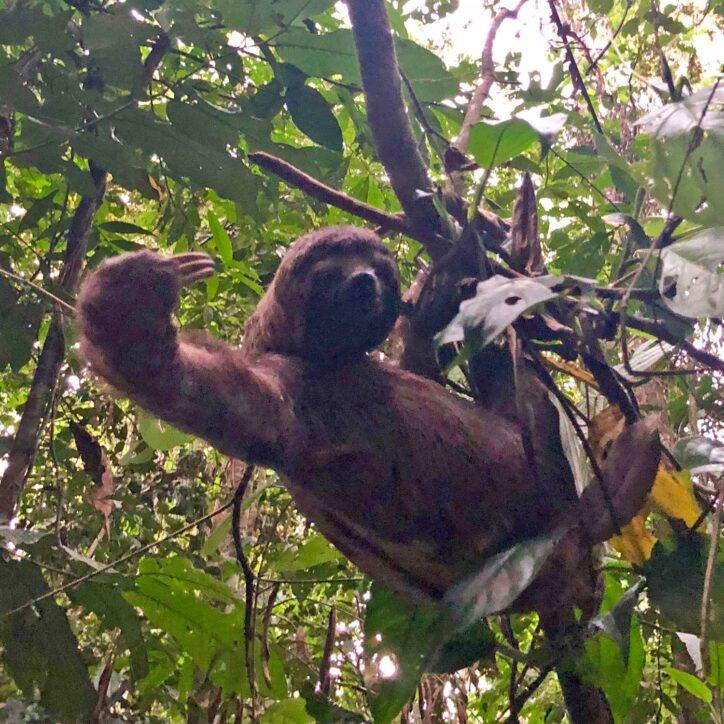
But I hold back and accept what I have been given, and I am rewarded. He slowly, oh-so-very-slowly unfurls and reaches out his three-toed paw to welcome me to the jungle. (Or to flip me the bird for waking him, but I’m pretty sure it was a welcome paw.) I look this magnificent creature in the eyes and the wide world between us shrinks and then he just curls into position and settles back to sleep.
I have no more need for a boat because now I can float, fly even.
WHEN TO GO
Aqua Expeditions offers three, four, and seven-night cruises on the Amazon in High Water Season from December through May, and Low Water Season from June until November. Both seasons offer incredible birding and wildlife viewing opportunities, but High Water season is a little cooler and flooded waterways allow tenders to travel deeper into the Amazon jungle canopy, while Low Water Season is warmer and brings opportunities to explore on land and view migratory birds in flight.
GETTING THERE
LATAM flies to 140 destinations in 25 countries. Fly overnight from New York to Lima and you arrive fresh as a daisy because no time difference=no jet-lag. It’s a further 90-minute flight from Lima to the river city of Iquitos. To get to the Aria Amazon’s pier at low water season requires a 90-minute drive from Iquitos to the launch point in the river town of Nauta. During high water season, guests can board the ship in Iquitos.
Last summer, LATAM inaugurated flights between Iquitos and Cusco, making two of Peru’s two most popular destinations—Machu Picchu and the Amazon—easily accessible on one amazing vacation.
